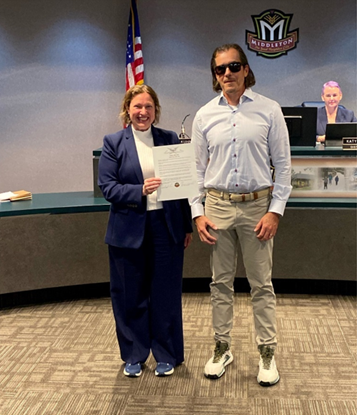
October was Pedestrian Safety Month and October 15 was White Cane Safety Day. These two observances work together to promote the safety of all Wisconsinites who get around without a car either all or some of the time. For the Council, it was a banner month of outreach, education and advocacy.
Governor Evers and over 30 municipal leaders across Wisconsin issued proclamations recognizing White Cane Safety Day and highlighting the importance of the state’s White Cane Law, which requires motorists to stop 10 feet from any pedestrian using a white cane or guide dog. The Governor’s proclamation asserted that “the state of Wisconsin reaffirms its commitment to upholding the White Cane Law and expanding services that promote the safety, dignity, and mobility of Wisconsinites of all abilities.”
“We’re grateful to these leaders for helping spread the message that keeping pedestrians safe, especially those who are most vulnerable in traffic, is everybody’s responsibility,” said Council Executive Director Denise Jess.
In all, 34 local governments, including several small towns and villages around the state, issued proclamations. Several municipalities invited the Council to send representatives to accept proclamations and speak in person at municipal council meetings. “I’m personally grateful and touched by board and staff members who took leadership roles to get in front of city councils around the state,” Denise said.
As part of Pedestrian Safety Month, Denise worked with the U.S. Department of Transportation’s Office of Civil Rights to present a workshop on Pedestrian Right-of-Way Accessibility Guidelines and Americans with Disabilities Act Requirements. The presentation was given to State of Wisconsin transportation planning leaders to increase awareness of requirements and best practices for accessibility.
As Council staff and board members engaged leaders in matters of pedestrian safety, a number of other state residents joined in the effort. A local Madisonian who is a new Orientation and Mobility client at the Council contacted the city about a dangerous intersection. His outreach resulted in a signal timing change that made a once perilous intersection safer. A resident in Rib Mountain launched a campaign to get accessible pedestrian signals installed in their tiny village. One such signal has been installed and another is planned for next year.
Those are just a couple of examples of successful pedestrian safety advocacy that took place this year. Work like this makes the Council confident that October’s momentum will carry over into the coming months and year. That’s a good thing because there’s a lot left to do. “We have much work to do yet, as every day many of us make dangerous crossings or navigate complex pedestrian situations with drivers who may not be attentive,” says Denise.
There are many measures communities can take to become safer and more welcoming for nondrivers and other pedestrians. Some require significant investment in infrastructural changes. Others mainly require the will and commitment to prioritize pedestrian safety in the community. The Council encourages folks to visit our website to learn about a few of the measures that can have a real impact at WCBlind.org/wp-content/uploads/2023/08/WCBVI-Pedestrian-Safety-2023.pdf
“From accessible crossing signals to properly designed curb ramps to comprehensive sidewalk networks, there’s a lot we can do to make our streets safer for pedestrians and build more welcoming, inclusive communities,” Denise says.

